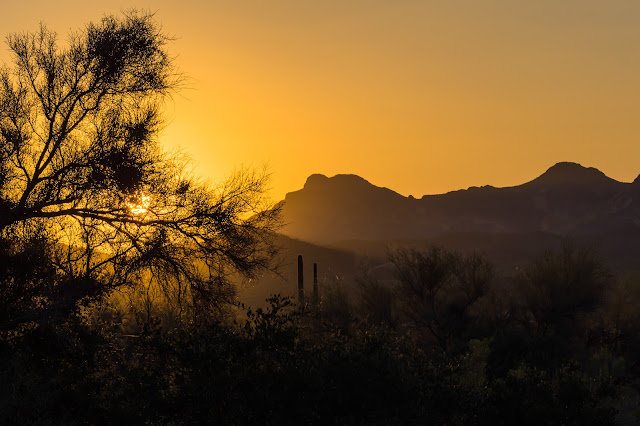The Plan
On Saturday, 6/20/2015, a fellow photographer invited me to try shooting the Milky Way from the Superstition Mountains which is about 40 miles east of Phoenix, by Apache Junction. He had seen a great picture on Facebook and wanted to try it too. I always like going to the Superstitions so it was a man date! (He had his wife along so it wasn't quite that weird.)
We decided to meet at the gate to the Lost Dutchman State Park which is at the north-west end of the Superstition Mountain range at around 8:00 PM.
I decided to look online for additional information about shooting the Milky Way so I'd hopefully be more prepared. I found a number of images such as this one on Flickr by Beth Myers. I noted that she used a Nikon D610 (YAY) with apparently the Nikkor 14-24mm f/2.8 lens. She shot hers at 3:02 AM on 5/3/2014. She used f/2.8 at 30s and ISO 1600 with a 14mm focal length. Since the full size image is 6016 x 4016 pixels (the size of the full images) I think she was fairly close to the mountain.
 |
| Stellarium Screen Shot from the Stellarium Website |
Using the information from this application you can find out what time the Milky Way will appear vertical, for instance. It roughly shows the location, displaying the major compass coordinates on the screen. It's really slick - I also paid for a version to install on my Kindle Fire HD, which I took with me to help visualize where the Milky Way should appear.
Mice and Men
We met at the park gate as planned, or there about. I got there early and had wandered into the park and took some pics while waiting. Spoiler alert - I liked these earlier pics as much as or more than the Milky way pic. Here's one of them: |
| Dusk over the Usery Mountains |
When it got dark enough we started taking some pictures. They just weren't very inspiring. We could see the Milky Way in the pictures a bit, but one thing I'd read was that you really should be able to see it with your naked eye (or eyes) in order to capture it well. And we couldn't.
I believe the issue was that it was pretty hazy. Normally I can see the Superstitions from Phoenix itself. On the drive out I could not see them from Phoenix but had to get closer, maybe to where I was within 15 miles or so, to see the mountains through the haze. I think that caused two issues: 1) it reduced visibility of the Milky Way, and 2) it captured "light pollution" in the atmosphere which also reduces the contrast of the Milky Way to the dark, empty space.
Here's my best picture, and this was edited quite a bit at this point:
 |
| Milky Way over the Superstitions #1 |
Post Processing
I found a good, succinct tutorial video that I watched (I really don't like videos much because I have to turn on a lot of other gear that I use for my recording studio in order to play audio from my PC). I watched it because the guy also offers some FREE presets for Adobe Lightroom specifically for processing night / sky / Milky Way images. The guy's name is David Kingham and his tutorial / presets page is http://www.davidkingham.com/night-photography-lightroom-presets. I used his advice and presets to get the picture above to the point it's at.
I wasn't very happy with it, though, compared to the Beth Myers image mentioned above, or others I'd seen. So I decided to try playing with it some more. Basically I took a copy of the above image (easy to do in Lightroom with a [CTRL][']) and tried to mainly bump up the exposure so that it wasn't so dark. Well, that lightened up everything too much so I used some filters to darken the sky above and below the Milky Way. I'd also used David Kingham's "star de-focus" preset on the upper and right stars but I thought it blurred the stars too much so removed most of that effect. Here's the final version which I like better:
 |
| Milky Way over the Superstitions #2 |
No comments:
Post a Comment